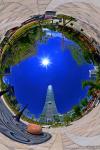
Song Jiang Jhen Battle Array in Neimen, Kaohsiung 2012 — 內門宋江陣
Neimen Dist., Kaohsiung City, Taiwan — 高雄市 內門區 內門紫竹寺
March 10, 2012, 02:32 UTC (10:32 TPE)
© 2012 Walker Young, All Rights Reserved.
In Taiwan, the battle array culture flourishes among the people, symbolizing their life force. Closely related to people’s everyday lives, battle array culture conveys the historical living patterns and folklore of Taiwanese in agricultural society. In rituals and religious ceremonies, battle array is an important ethnic performance function to entertain the gods and people; it especially prospers in southern Taiwan. Among civil and military arrays, the Song Jiang Jhen Battle Array (the battle array used in the Song Dynasty; now a kind of kungfu performance) is the most frequently performed. With the highest number of performers, it emphasizes uniting and protecting the people to resist invasion. Demonstrating Taiwanese’s energy, it is a representative form of grassroots folk art. In short, it is the epitome of Taiwan’s grassroots culture.
In Neimen, Kaohsiung, the battle array culture is preserved intact. With the highest number of array performance groups in Taiwan, the Song Jiang Jhen Battle Array is the best in the world, a representative kind of martial arts and ethnic performance in Taiwan. For a long time, the regional government has insisted on preserving and promoting the development of battle array culture. With constant endeavor, the government preserves and promotes it incessantly. More importantly, new elements are added in response to the changing times.
Since 2005, Neimen has been sponsoring the Intercollegiate Song Jhiang Jhen Battle Array Competition in the Guanyin Festival or Matsu Festival; all college and university students in Taiwan are invited to join this contest. With this opportunity, they can learn more about the Song Jhiang Jhen Battle Array and to feel the power of grassroots culture and people’s determination in everyday life. Joining this contest, all participants are eager to animate the spirit of Neimen by performing the Song Jhiang Jhen Battle Array. Each year more and more people to come to this badland, Neimen, attracted by the exhilarating activities. In addition, visitors can eat in the free feasts offered by local people as they enjoy festive excitement and feel the Song Jhiang culture in Neimen.
After years of promotion, through a joint venture of the regional government and the central government, this folk event has been transformed from an ethnic performance into refined performing arts.
In 2012, it is the 101st anniversary of the Republic of China. In this historical moment, we would like to promote this ethnic activity further, providing more opportunities for battle array culture to give out more light and heat. Southern Taiwan is the home of battle array culture. It is the honor of Greater Kaohsiung to promote this event! (Tourism Bureau of Kaohsiung City)
內門宋江陣
宋江陣流傳於台灣南部,以台南、高雄兩大市為主,其中高雄市內門區宋江隊伍最多,堪稱藝陣之鄉。高雄市內門區的宋江陣,為配合內門紫竹寺觀音佛祖遶境,融合水滸傳情結,排練而成宋江戲,進而演變民俗藝陣-宋江陣,有驅邪避煞、開路解厄等功能。
1. 古典文學「水滸傳」的攻城武陣。
2. 少林武學的實拳派。
3. 戚繼光的「藤牌舞」或「鴛鴦陣」。
4. 鄭成功的「藤牌兵」或「五花操兵法」。
5. 福建漳泉地區的團練。
6. 清末台南府城的「義民旗」。
宋江陣的兵器,大部分仿效水滸傳裡的角色,人手一樣兵器,像是頭旗大統領宋江、雙眼副統領盧俊義、雙斧黑旋風李逵、大刀關勝等,隨著角色不同,所持的兵器也不同。除了常見的宋江陣外,宋江陣尚有宋江獅陣、宋江龍陣及宋江鶴陣,分辨方法為:「跋頭旗」(頭旗從頭到尾猛力的搖個不停)是宋江陣,「跋獅頭」是宋江獅陣,「跋龍頭」是宋江龍陣,「跋白鶴」是宋江鶴陣。宋江陣有兩大禁忌:一是禁止民眾入陣或從中穿越,因那是代表破陣之意。二是絕不可以擋住正門或中道。
十八套的陣式演練,水滸傳的108條好漢,皆伴隨地區、師父、表演成員而有所改變,目前以36人的陣式最為常見。高雄市內門區的傳統宋江陣現今仍各自保存其獨特宋江陣法,世代流傳。
Lat: 22° 55' 0.77" N
Long: 120° 27' 17.97" E
Elevation: 76.265
Precision is: High. Pinpoints the exact spot.
Software: PTGui, Photoshop CS4


 Tap or click the zoom icon in the bottom right corner of the picture to switch between in-page and fullscreen view
Tap or click the zoom icon in the bottom right corner of the picture to switch between in-page and fullscreen view